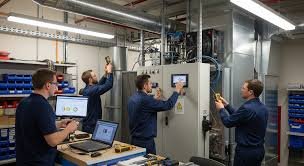HVAC System Validation in Pharmaceuticals | A Complete Guide to Compliance and Best Practices

HVAC System Validation in Pharmaceuticals
A complete guide to compliance, qualification, and best practices for pharmaceutical facilities.
1) Introduction
Heating, Ventilation, and Air Conditioning (HVAC) systems in pharmaceutical facilities are critical utilities that ensure controlled environments for manufacturing, testing, and storage of medicinal products. Proper validation and qualification of HVAC systems are essential for compliance with GMP, sterility assurance, and contamination control.
2) Objectives of HVAC System Validation
- Ensure consistent environmental control (temperature, humidity, particulate levels, differential pressure).
- Maintain product quality and patient safety.
- Demonstrate compliance with regulatory standards (EU GMP, US FDA, WHO, ISO).
- Prevent cross-contamination through effective airflow and pressure cascade design.
- Support cleanroom classification per ISO 14644 and Annex 1.
3) Regulatory & Guidance References
- EU GMP Annex 1 (2022): Manufacturing of sterile medicinal products – HVAC design & qualification.
- WHO TRS 961, Annex 5: HVAC systems for non-sterile dosage forms.
- ISO 14644-1/2: Cleanroom classification & monitoring.
- ASHRAE Guidelines: HVAC design practices.
- US FDA Guidance: Aseptic processing & environmental controls.
4) Key HVAC Design Considerations
- Air Classification: ISO 5–9 (EU Grades A–D).
- Air Changes per Hour (ACH): Based on room classification and occupancy.
- Airflow Patterns: Unidirectional (laminar) vs turbulent flow.
- HEPA Filtration: Terminal filters for cleanrooms; integrity testing required.
- Pressure Differentials: ≥10–15 Pa between cleanroom grades.
- Temperature & Humidity Control: Typically 18–25 °C and 45–60% RH (product-dependent).
- Return Air Strategy: Low-level returns for particle control.
5) Validation Lifecycle
5.1 Documentation
- URS → DQ → IQ → OQ → PQ → Routine Monitoring → Requalification.
- Risk assessment (FMEA/RA) to identify CPPs/CQAs.
5.2 Installation Qualification (IQ)
- Verify equipment installation against design specs.
- Check ductwork, AHUs, filters, sensors, dampers, alarms.
- Calibration of instruments.
- Verification of P&IDs, drawings, and utilities.
5.3 Operational Qualification (OQ)
- Airflow velocity & uniformity tests.
- HEPA filter integrity (DOP/PAO test).
- Differential pressure verification.
- Alarm and BMS/SCADA system checks.
- Temperature & humidity uniformity tests.
- Recovery test (clean-up time).
5.4 Performance Qualification (PQ)
- Room classification at rest and in operation (ISO 14644, EU GMP Annex 1).
- Microbial monitoring (settle plates, active air, contact plates, swabs).
- Particle monitoring during dynamic conditions.
- Smoke visualization for airflow patterns.
- Pressure cascade verification.
6) Critical Tests in HVAC Validation
- Airflow Visualization (Smoke Test): To confirm unidirectional flow and no dead zones.
- HEPA Filter Integrity Test: Ensures proper sealing and efficiency.
- Differential Pressure Test: Confirms pressure cascade between rooms.
- Temperature & Humidity Mapping: Identifies uniformity across the area.
- Air Change Rate Calculation: Based on supply air volume and room size.
- Recovery Test: Time required to return to specified cleanliness level after contamination.
- Particulate Monitoring: Non-viable particle counts per ISO 14644.
- Microbial Monitoring: Environmental monitoring for viable organisms.
7) Acceptance Criteria (Typical)
| Parameter | Typical Limit |
|---|---|
| Differential Pressure | ≥10–15 Pa between grades |
| HEPA Filter Integrity | ≥99.97% at 0.3 μm |
| Temp. Uniformity | 18–25 °C (product-dependent) |
| RH Uniformity | 45–60% (product-dependent) |
| Particle Counts | As per ISO 14644 / EU GMP Annex 1 |
| Recovery Time | ≤15–20 minutes (to baseline) |
8) Environmental Monitoring Program
- Continuous Monitoring: Particle counters, differential pressure gauges, temp/RH sensors.
- Routine Monitoring: Settle plates, active air samples, surface swabs.
- Alert & Action Limits: Defined based on cleanroom classification.
- Trending: Data trending and deviation analysis.
- Frequency: Defined per risk assessment.
9) Risk Assessment in HVAC Validation
- CPPs: Airflow velocity, pressure differentials, HEPA filter integrity, ACH, temp/RH.
- CQAs: Room cleanliness, microbial control, product protection.
- Tools: FMEA, HACCP for contamination control.
10) Routine Controls & Requalification
- Daily: Pressure differential & temp/humidity checks.
- Weekly/Monthly: Particle & microbial monitoring.
- Semi-annual/Annual: HEPA filter integrity, airflow visualization, recovery tests.
- Change-based Requalification: After filter changes, major maintenance, or layout modifications.
11) Documentation & Data Integrity
- All data must be ALCOA+ compliant.
- Use calibrated, validated monitoring systems.
- Maintain audit trails for electronic systems (BMS, EMS).
- Deviations, CAPA, and change control integrated.
12) Common Issues & Troubleshooting
- Pressure Cascade Failure: Check door seals, leakage, AHU balance.
- Hot/Cold Spots: Rebalance air distribution, add diffusers.
- Filter Leakage: Reseat or replace HEPA filters.
- High Particle Counts: Investigate gowning, personnel practices, cleaning.
- Condensation Issues: Review humidity control, insulation, cooling coils.
13) Best Practices
- Design for ease of maintenance (filter access, duct cleaning).
- Define clear SOPs for monitoring and deviations.
- Train staff on contamination control & cleanroom behavior.
- Establish robust change control procedures for HVAC modifications.
- Use energy-efficient AHUs with monitoring to reduce OPEX.
14) Conclusion
Validation of HVAC systems in pharmaceutical facilities ensures environmental control, compliance with GMP, and protection of product quality. A lifecycle approach—from design to requalification—provides assurance of consistent performance. Robust documentation, risk management, and routine monitoring are essential pillars of sterility assurance and contamination control.
15) Quick Takeaways
- Validate HVAC via IQ, OQ, PQ with robust protocols.
- Confirm airflow, HEPA integrity, pressure cascades, temp/RH, and recovery.
- Link validation to Annex 1, ISO 14644, WHO TRS requirements.
- Implement continuous monitoring with defined alert/action limits.
- Maintain strong data integrity and change control.
🎓 Discover one of the best Pharmaceutical Microbiology course available —click below to explore the course that’s shaping future Microbiology course skills.

